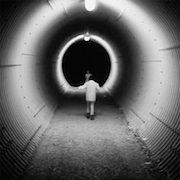Philippe Garrel’s 1968 film Le Révélateur, made at a time of infamous upheaval in his home country France, is, like Carl Theodor Dreyer’s classic The Passion of Joan of Arc, intentionally silent, letting its powerful visual relationships between the characters—a young, curious boy and his parents—and the stark oft-fabricated environments that contain them do the talking. Given the film’s lyrical movement of contrasting light and anxious bodies, the vacuous overall silence becomes progressively heavier, almost unbearable, as the film proceeds through its 65-ish minutes. As with The Passion of Joan of Arc, then, Le Révélateur calls out for musical accompaniment to match its tragic story, even if it such accompaniment wasn’t intended by the director. And as with Loren Connors and his score for Dreyer’s film, harpist Mary Lattimore and multi-instrumentalist Jeff Zeigler take up the soundtracking task carefully, allowing the film’s preconceived silent landscape and overall sense of tension inform their portentous, restrained, deftly performed score (reviewed here in its slightly condensed, LP-friendly form).
In addition to their solo and duo outputs, the Philadelphian musicians are coveted hired hands, aiding the recordings and performances of artists like Kurt Vile, Steve Gunn, Wrekmeister Harmonies, and numerous others. Where their musical capabilities provide nameless, understated depth to, say, Kurt Vile’s Smoke Ring for My Halo, Lattimore and Zeigler’s respective commands of their instruments ring proudly throughout Music Inspired by Philippe Garrel’s Le Révélateur. Lattimore in particular introduces her harp right away as an articulated melodic, perhaps narrative, tool. At the album’s outset, on ‘Glimmering Light’, it’s as though she’s discovering herself, her surroundings, feeling the strings without regard for pattern and meter to understand them materially; the approach echoes one of Garrel’s first shots, wherein the immobile female character lets the male feet her water and a double-length cigarette that breaks upon lighting.
Shortly afterwards in the film, the title card is bookended by two radically contrasting shots of the boy protagonist alone: in one, he sits underneath a staircase a bright white room; in the other, he walks through a shimmering tunnel. Garrel communicates themes of immobility, loneliness, containment, yearning, and distance with intimate clarity. Accordingly, track two of the soundtrack, ‘A Tunnel’, takes up similar concerns: Lattimore repeats a short, sedated theme that comes back again and again as the album unfolds. Each time it returns, often emerging from a puddle of Zeigler’s mediated guitar hums, the harp theme gives the listener a gentle, yet pointed prick, activating the memory-laden relationship that Garrel fosters between his protagonist and his viewer. The literally sharp quality of the harp suggests the instrument as the album’s punctum; more than the sounds themselves, however, it’s the sense of distance—temporal distance between Lattimore’s lagging plucks as well as an ineffable, yet palpable air of separation—that connects the listener or viewer to Garrel’s film.
The compositional variety peppered throughout the rest of the LP sometimes requires a careful ear to notice: Lattimore and Zeigler, with their dedication to the arpeggiated harp theme, often update French composer Erik Satie’s formula of subtle—sometimes imperceptible—variation. Every now and then the duo institutes changes more forcefully, though, to help maintain aural interest. ‘A Forest’ and ‘Running Chased’ privilege Zeigler’s guitar and synthesizer wizardry over Lattimore’s harp, perhaps reflecting the boy character’s dissociation from the theoretically stable world his parents built for him. Underscoring the familial tension and subsequent release, ‘Family Portrait’ upsets the album’s gentle touch with dissonant harp and jagged electronic rhythms; that said, it soon dissipates into ‘A Road’, which emphatically, yet quietly restates the theme. ‘Laurent and Bernadette’, with self-contained drama and synthesized effects fit for a early twentieth-century Parisian café buried in the mix, represents the album’s best candidate for a standalone song. Which is to say, while the music lends elegant pathos to Le Révélateur, listening to it front-to-back as an album, as with many scores, is slightly—indeed, only slightly—less rewarding. To invoke Satie once more, Music Inspired by Philippe Garrel’s Le Révélateur projects a ‘furniture’-like quality—one that makes the surrounding room decidedly more tense, more interesting, whether it’s screening Le Révélateur, another silent film, or nothing at all.


